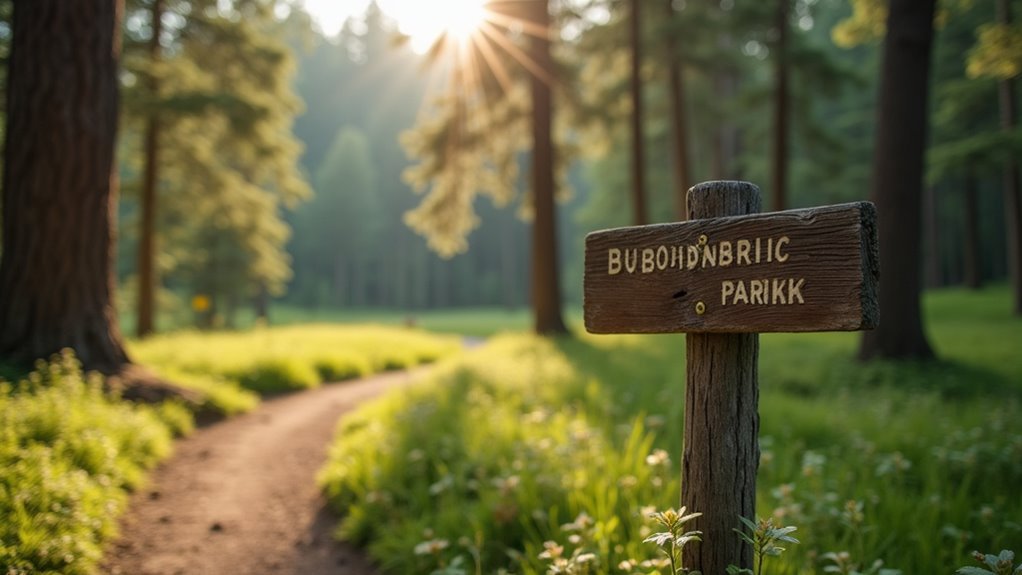Some of the links in this article may be affiliate links. If you make a purchase through these links, we may earn a small commission at no extra cost to you. Thank you.
I’ve seen a million geocachers get into hot water over placement rules, and I don’t want that to happen to you. You might think you can hide your clever little container anywhere that seems fun, but the reality is much more complex. I’ll guide you through the legal maze of permissions, restrictions, and requirements that’ll keep your cache from being archived—or worse, landing you with a trespassing charge.
Obtaining Permission From Private Property Owners

Securing permission from property owners isn’t just a formality—it’s an essential first step in responsible geocaching.
In my experience, the most effective approach is to request permission in person when the property owner is present.
Face-to-face permission requests create immediate dialogue and build valuable connections with property owners—a cornerstone of ethical geocaching.
This face-to-face interaction allows you to address any concerns immediately and build rapport.
If you can’t meet in person, I’d recommend checking the property’s website for accurate contact information.
Whatever method you choose, make sure you’ve explicitly received permission from the property owner before placing your cache.
Don’t assume that general permission to access the property means you can hide a geocache there!
You’ll need to confirm that your specific hiding spot is approved.
This might seem like extra work, but trust me, it’s much better than having your cache removed later.
Navigating Public Land Management Authorities
When it comes to placing geocaches on public land, things get a bit more complex than dealing with private property.
I’ve found that consulting the Regional Geocaching Policies Wiki is your best first step—it’s a goldmine of information about local regulations and permit requirements.
If you’re unsure who manages a particular area, just search online or call nearby agencies.
They’ll point you in the right direction.
I think it’s also smart to reach out to owners of existing caches in the area; they’ve already navigated the system successfully.
Be prepared to meet with land managers in person.
Bring specific details about your cache and maintenance plans.
Restricted Locations and No-Go Zones

I can’t emphasize enough how important it’s to know where you absolutely shouldn’t place a cache.
You’ll need explicit permission from property owners before burying anything, and certain areas like airports, train stations, and environmentally sensitive lands are completely off-limits.
When in doubt about a location, I always check the Regional Geocaching Policies Wiki first – trust me, it’s much better than dealing with the headache of having your cache archived or, worse, facing legal consequences.
Prohibited Placements
Understanding where you can’t place a geocache is just as important as knowing where you can.
When following Geocache Hiding Guidelines, I’ve learned that you absolutely can’t bury caches without explicit permission from the property owner.
It’s not just about land policies—it’s about respect and accessibility.
I’ve seen people make the mistake of planning event caches near airports or train stations.
Don’t do this!
It’s prohibited for safety reasons.
Also, if you can’t access your cache most days of the week, it’s a no-go.
And those vacation caches?
They’re rarely approved unless you’ve got a solid maintenance plan in place.
Oh, and CITO events need special partnerships—you can’t just organize one on your own.
Respecting Protected Lands
Now that we’ve covered where geocaches shouldn’t go, let’s look at protected lands—which honestly trips up even experienced cachers.
Before you hide the cache on any protected property, you’ll need explicit permission from the managing agency.
I can’t stress this enough!
Here’s what you need to know:
- Check the Regional Geocaching Policies Wiki first—it’s a lifesaver for current regulations
- Never bury caches in environmentally sensitive areas (the wildlife will thank you!)
- Transportation centers and military zones are pretty much automatic no-gos without authorization
- Document all permissions you receive—trust me, you’ll need proof later
- Failure to follow these rules can get your cache archived or permanently removed
Environmental Considerations and Impact Assessment
I’m passionate about protecting our natural spaces while enjoying geocaching, so let’s talk about keeping our environmental impact minimal.
Before placing a cache, I always check for sensitive habitats nearby—areas with rare plants or animal nesting grounds shouldn’t be disturbed just for our game.
You’ll want to use techniques that leave no trace, such as choosing natural hiding spots rather than digging or damaging vegetation, which I’ve found keeps park rangers happy and preserves these beautiful areas for everyone to enjoy.
Natural Area Protection Guidelines
The natural areas where you’re placing geocaches deserve special protection, and I’ve got to emphasize that environmental considerations should be at the top of your mind during the planning phase.
When you hide your container, remember that cache owners must obtain permission from land managers who’ve the final say on placement decisions.
Here are critical guidelines to follow:
- Never bury caches in natural areas without explicit permission to prevent soil erosion
- Check the Regional Geocaching Policies Wiki for specific permit requirements in parks
- Make sure your placement complies with local environmental laws to minimize habitat disruption
- Create a maintenance plan that accounts for environmental impact
- Understand that non-maintained caches damaging habitats may be archived, and you might lose privileges
I think these steps aren’t just bureaucratic hurdles—they’re essential for preserving the natural spaces we all enjoy.
Sensitive Habitat Awareness
When considering placement of your geocache, have you thought about the delicate ecosystems you might disturb?
Before you hide your cache, I’d strongly recommend conducting an impact assessment by checking the Regional Geocaching Policies Wiki.
Trust me, it’s essential to avoid sensitive habitats where endangered species live.
I’ve learned—sometimes the hard way—that a cache placed in protected areas can disrupt wildlife migration or, you know, interfere with breeding grounds.
Remember, you can’t bury your cache without explicit permission, as it damages soil and root systems.
If your cache negatively impacts a sensitive habitat, reviewers might archive it.
Minimal Footprint Techniques
How can you make sure your geocache leaves virtually no trace on its surroundings?
I think the key is careful planning before you place anything.
When I’m setting up a new cache, I always try to minimize my environmental impact—it’s just good Geocaching etiquette.
Here are some approaches I’ve found effective:
- Use existing structures rather than creating new attachments
- Avoid burying containers without proper permission
- Place caches in durable locations that won’t damage vegetation
- Communicate with your reviewer about placement concerns
- Commit to regular maintenance to prevent unintended effects
Remember to check the Regional Geocaching Policies Wiki first.
Land management rules vary wildly, and what’s allowed in one park might be forbidden in another.
Trust me, doing a quick impact assessment upfront saves headaches later!
Container Safety and Appropriate Placement
Selecting proper containers for your geocache isn’t just about aesthetics—it’s an essential safety consideration I can’t stress enough.
Container selection is critical for geocache safety, not merely a cosmetic choice—a responsibility every cache owner must prioritize.
When I choose containers, I always make sure they’re sturdy and waterproof.
Trust me, nothing disappoints the geocaching community more than finding soggy logbooks!
The size matters too—you’ll want something that fits your hiding spot but is large enough to hold a logbook and maybe a few trinkets.
I think the best approach is to go as big as your location permits without creating an eyesore.
Don’t forget to check if your container suits the environment.
I’ve seen caches fail because, well, plastic can crack in extreme cold or heat.
When you create your cache page, include container details so finders know what to look for.
Documentation and Maintenance Requirements

Documentation serves as the backbone of responsible geocaching—you simply can’t skip this step.
When submitting your cache page to Geocaching HQ, you’ll need to include all permission details, container specifics, and your hiding method.
I’ve found that meticulous documentation saves headaches later on.
Maintenance isn’t optional either.
In fact, it’s one of the most important commitments you’ll make as a cache owner.
- Monitor your cache logs regularly, especially “Owner attention requested” notices
- Respond promptly to issues—I check mine weekly through the Geocaching® app
- Make sure your cache remains accessible most days of the week
- For vacation caches, document a solid maintenance plan before submission
- Remember, neglected caches could cost you your hiding privileges
Frequently Asked Questions
How to Get Permission to Hide a Geocache?
I’ll seek permission from property owners or managers to avoid lawsuits, always respecting their rules. I’ll consider environmental impact when placing my cache and document all approvals for reviewer submission.
What Are the Rules for Hiding Geocaches?
Looking for key geocache rules? You’ll need landowner permission, a maintenance plan, and must follow environmental guidelines to protect nature while creating a sustainable, accessible hide that includes a logbook.
Where Can I Hide a Geocache?
I can hide geocaches in urban spots or forest trails after getting permission from the property owner or manager. I’ll check Regional Geocaching Policies Wiki for public lands requiring permits.
Do You Need Permission to Place a Geocache?
Yes, I always need permission to place a geocache. There aren’t any Permission Exemptions—despite Ethical Debates, the fundamental guideline requires me to secure approval from landowners or managers first.